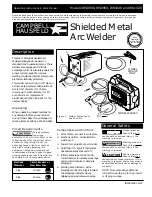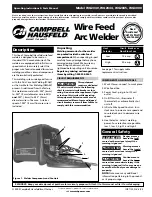
25
Gas Flow Regulators - Sheilding Gases - Gas Flow Rates
Gas Flow Regulators
The job of the gas flow regulator is to reduce the bottle pressure gas down to a lower pressure and deli
-
ver it at a constant flow. This constant flow of gas is usually fed through the welding machine where it is
controlled by a solenoid valve, operated when the torch trigger is pulled. Once the gas has passed the sole-
noid valve it flows down the torch cable exiting at the gas nozzle to protect the weld pool and surrounding
area. There are two main types of flow regulators commonly used for MIG and TIG welding applications.
Both regulator types perform the same function, but have a different way of setting and measuring the gas
flow. A flow-gauge regulator (Fig.1) has a dial-type pressure gauge to measure the cylinder contents and a
second gauge to measure and deliver the flow rate required.The flow-meter regulator (Fig.2) has a pres
-
sure gauge to measure the cylinder contents and a flow tube assembly to measure and deliver the flow
rate required. Some flowmeter regulators will have two flow tube assemblies (Fig.3) typically one is used
for supplying gas to the welding machine and the other is used used for purging the welding area with gas
prior to welding, during welding and post welding and at a separate rate of flow from that being supplied to
the welding machine. The amount of gas flow needed to do the job will depend on the welding gas and the
job being done, but a common setting to start with is 10 L/min.
Shielding Gases
Shielding gases are almost always necessary for MIG and TIG welding processes to protect the weld zone
from gases that are contained in the surrounding atmosphere, particularly nitrogen and oxygen. If allowed
into the weld zone these gases will contaminate the weld pool resulting in fusion defects also porosity and
embrittlement of the weld metal. Selecting the right type of shielding gas depends on the welding process
being used and type of material being welded.
The MIG process is typically a mixture of Argon and Co2 (AR90% Co2 10%) or pure Co2 for steel welding
applications, other specialised mixtures of Argon, Co2, and Oxygen are available for stainless steel welding
but with welding aluminium pure Argon is almost always used
The TIG welding process almost always requires 100% Argon for welding of all materials, however in some
specialised applications Helium, or a Helium mix are sometimes used.
Today with the multitude of gas mixes available through a number of different suppliers, it is difficult to list
and recommend which gas mix is better for which job. If you are unsure about what gas or gas mix to use
we recommend you discuss with your application local gas suppliers or your Esseti technical representative.
Gas Flow Rates
For MIG applications the ideal gas flow rate will depend on the type of mig wire, wire feed speed and current
being used and also the type metal transfer mode, i.e. Dip Transfer, Spray. Pulse Mig. Long interconnecting
cables between the power source and wire feeder and also long push pull torch cables may require higher
flow rates to compensate for the distance. As a general rule of thumb;
1. Small weld pools use 10 L/min,
2. Medium weld pools up to 15 L/min
3. Large spray, pulse mig weld pools use up to 25 L/min.
It is important to note that too high gas flow can be just as bad as having too low flow rate. The reason being
that if the gas flow exits the gas nozzle a too high rate it can.
1. create a vortex and draw air into the gas flow and the weld zone causing contamination of the weld.
2. produce turbulence at the weld pool resulting in a poor quality weld.
For TIG applications the ideal gas flow required will depend on the welding job being done, the type of ma
-
terial being welded and the type of filler wire. As a generalguide start with a flow rate of 6 l/min. If porosity or
contamination appears in the weld then increase the flow rate. Also be aware of the welding environment, if
there is wind or a breeze an increase of flow rate will be required to compensate for this.
Fig.1
Fig.2
Fig.3
Содержание Razor Weld ARC180
Страница 28: ...28 New Zealand Limited RazorWeld RazorCut ...




































